As I’ve hinted at, my exciting news is that I have returned to NASA and am once more fully engaged in researching Human and Robotic Motion! This also explains why this blog has gone quiet for many weeks — I have been fully engaged in the period of transition and re-balancing my life.
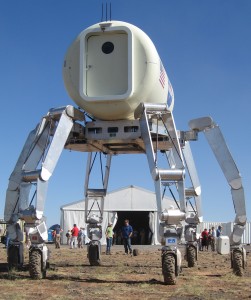
The ATHLETE Robot standing tall at Base Camp. This is the robot I have been developing walking algorithms for.
This was accompanied by a wild burst of energy to pull our project together in time for an Agency-wide robotics field test called Desert Research and Technology Studies (D-RATS) 2010, held at Black Point Lava Flow in Arizona. I have just returned from this adventure two weeks ago and am excited to share thoughts and pictures!
D-RATS is an annual field test led by NASA in collaboration with non-NASA research partners. The primary goal of D-RATS, is to do earth based experiments of future mission concepts and technologies. Thus we go to remote locations that have some analog aspects of exploring the moon or mars, and test out new robotic systems, mission control strategies, and approaches to how one explores.
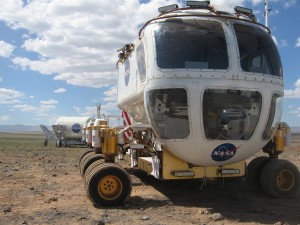
The SEV rover. It can independently control its wheels so it can drive sideways, diagonal, or spin in place. It can also lift and lower its body to clear obstacles. I got to drive it for a while, which was excellent fun!
The importance of these last two aspects was an interesting lesson for me at my first field test at Moses Lake Sand Dunes two years ago. It is easy to get excited about new technology, such as an advanced robot, but how do you control it from another planet without any ability to physically intervene? The details of how the ground control teams operate is altered by the introduction of new capabilities on-board the robot. Thus, in evaluating new technology, it is important to evaluate the entire operational scenario. Likewise, if you wish for your new technology to be adopted on a future mission, it helps to show how it fits into a realistic operational setting and how it impacts the way ground control operates.
Of course, all the technology and operational controls exists to support the key question of what can we learn? Science! Exploration! These are (mostly) the goals of space exploration. As new instruments and robotic platforms are designed we need to evaluate the quality of the science that can be performed with them. D-RATS evaluated this by sending the Space Exploration Vehicle (SEV) rovers (with 2 person “astronaut” teams on board each) and the ATHLETE rover on a 14 day traverse over the lava fields. The ground control included a science back-room staffed by geologists and other scientists who were not familiar with the geological history of the area. Over the period of the 14 day traverse the scientists and flight team directed the remote robots and astronauts in an effort to unravel the history of the area which includes a number of different lava flows and complex geological history. The resulting theories of the areas history can be compared to what is actually known and the effectiveness of the new technology and operations can be evaluated.
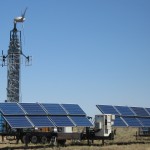
A portable solar, wind, and cellular communications tower that collapses onto a trailer. Great for earth based uses.
Communication, flight control, support teams, and many other mission functions were located at a base-camp. This was also the location at which a number of other technology tests and demonstrations were conducted, including a Habitat Demonstration Unit, the Centaur 2 robot, a fuel cell system, and Green Trail’s portable solar-wind-communication system, to name a few. I arrived at the base-camp as the 14 day traverse was ending and watched with joy as the mock habitat on top of ATHLETE first became visible on the horizon, looking much like a futuristic vision of the western settlers wagon, or maybe a Lunabago.
My project, which I worked on with my colleague DW Wheeler, was to demonstrate planning and control of the ATHLETE robot walking over a rocky terrain using the “Footfall Planning” software we have been developing for the last four years. This all happened at base-camp after the robots completed their traverse, so I was not directly involved in those aspects of the field test. We were successful at the demonstration, and I will talk about it in detail in my next post.
I will tell one funny story though — in order to demonstrate ATHLETE walking around rocks, I needed to gather a few large rocks at the robots feet. I was busy rolling a boulder across the desert for this purpose when the new Centaur 2 robot came to my rescue. The team which had brought the robot and its new earth moving scoop were busy testing it and seeing what it was capable of. We were all impressed that it was able to pick up and carry the rock, which was heavy enough to occasionally cause Centaurs back wheels to come off the ground slightly. This little robot is intended to use tools like shown, and also to be a mobility platform for the Robonaut 2 humanoid (a *very* cool machine which I may get to work with again this year).
Like with previous field tests, DRATS was difficult, exhausting, stressful, and wonderful all at the same time. Predictably, nothing works quite like you expect when you get there, and it is a mad scramble to get it all sorted out with very little time to spare. It was especially challenging for us, because we were testing many things on the robot for the first time. But, as I’ve seen before, all that hard work is also key to building friendships, community, and magical moments. When it works — when the robot takes its first steps, it is a beautiful moment! I’ve also seen, again and again, that the shared effort of creation is one of the best ways to build community. And in that respect, the DRATS field tests are wonderfully effective, bring together teams of robotics researchers from different NASA centers across the country, enabling the sharing of work, ideas, problem solving, plans, and thoughts about the future of space exploration.
I would like to end with a formal disclaimer — I do not work for NASA (I’m employed by a contracting company — SGT Inc.), and everything written here is my personal observations and is not part of my work.
.

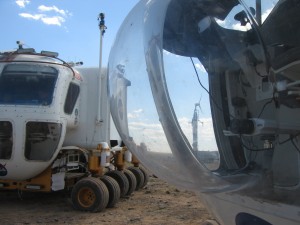

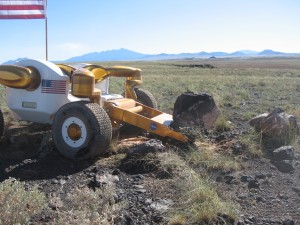
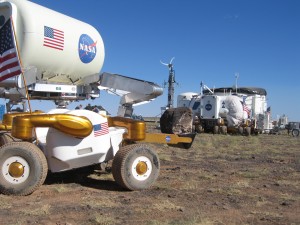




Vytas,
Thank you for taking the time to post this. It was really a pleasure to see what these robots look like. What a marvelous job you have!
Thanks so much for posting this! I was wondering if you had any additional photos of the Centaur 2 robot that came to your rescue. I am a current NASA CAS Scholar and my modules involve scenarios with Centaur 2 and R2. Finding information or photos of Centaur has proven difficult, yours here is the first I’ve seen!
Hello! I’m glad that you enjoyed the post and pictures! If you are looking for photos of Centaur and R2 here are a couple:
http://www.flickr.com/photos/nasarobonaut/5474040622/
http://www.flickr.com/photos/nasarobonaut/5474040352/
http://www.flickr.com/photos/nasarobonaut/5478897371/